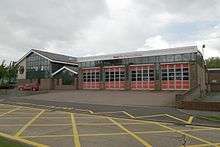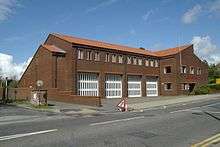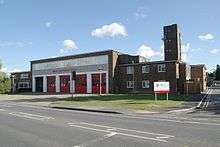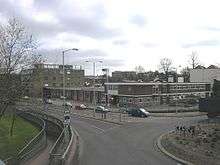Kent Fire and Rescue Service
 | |
| Operational area | |
|---|---|
| Country |
|
| Country |
|
| County |
|
| Agency overview | |
| Employees | 2,000 |
| Facilities and equipment | |
| Stations | 55 |
| Website | |
| Official website | |
Kent Fire and Rescue Service is the statutory fire and rescue service for the administrative county of Kent and the unitary authority area of Medway, covering a geographical area south of London, to the coast and including major shipping routes via the Thames and Medway rivers. The total coastline covered is 225 km (140 mi); it has 55 fire stations, and 4 district fire safety offices. The FRS provides emergency cover to a population of nearly 2 million.[1]
The area meets the boundaries of the London Fire Brigade to the north of the county, Surrey to the north west and East Sussex to the south west of Kent.
History
The first fire brigade appeared in Kent in 1802 when the Kent Fire Office formed an insurance brigade in Deptford (which was at the time part of Kent). In the same year, and completely separately from insurance companies, Hythe became the first town in Kent to set up its own fire brigade, followed by Ashford in 1826.
By the 20th century, it was quite fashionable for local authorities to have their own fire brigades. Maidstone had seen the formation of its borough fire brigade in 1901 when the Royal Insurance Company provided a new Shand Mason horse-drawn steam fire engine, named The Queen. This company had taken over the Kent Fire Office in the same year, simultaneously disbanding their own brigade. Things often became very competitive between individual town and village brigades, in many instances, each one trying to outdo its neighbour. In 1910, Bromley became the first town in Kent to house motorised fire engines, with two new Merryweather vehicles being stationed there.
Until 1938, the provision of a fire brigade was a discretionary power, and naturally there were a few local authorities that regarded it as an unnecessary expense. However, due to the threat of war, Parliament enacted the Fire Brigades Act 1938 and made it a duty and so created over 1,600 individual fire authorities across the nation. It was these local brigades and the Auxiliary Fire Service – also formed in 1938 – that valiantly coped with the consequences of the Battle of Britain and much of The Blitz. In August 1941, local brigades and the AFS were absorbed into one organisation called The National Fire Service. It was in 1941 that the current Headquarters house The Godlands was requisitioned for war-time use by the National Fire Service and it has remained with the fire service ever since.
World War II brought dark days indeed for Kent fire-fighters. Fire-fighting has been and will probably always be a dangerous occupation, and the Roll of Honour 1899-1990, compiled by Geoffrey Cooper, an ex-Kent fire-fighter, details the deaths of Kent fire-fighters while on duty. Of the 122 'Kent' names listed, 15 were pre-1939, 16 were post-1939 and 91 died during World War II. Nationally, well over 1,000 fire-fighters died during World War II, with stories of fire stations and the water supplies needed for fire-fighting being targeted by German bombers, to maximise the damage caused by incendiary bombs. The last death on duty of a Kent fire-fighter was in 1990.
The fire service was returned to local authority control on 1 April 1948 under the Fire Services Act 1947, with responsibility in England and Wales being given to the 146 counties and county boroughs of the day. The County of Kent and the City and County Borough of Canterbury combined to form Kent Fire Brigade, taking over 79 fire stations from the National Fire Service.
Subsequent local government reorganisations have had their effect upon the brigade, most significantly in 1965 when eight fire stations in the northwest of the county were transferred to the newly created Greater London area. Further reorganisation in 1974 saw Canterbury lose its county borough status and the fire brigade became the exclusive responsibility of Kent County Council. In 1998, the structure of local government changed again and Kent combined with the new Medway Towns unitary authority for fire brigade provision.
On 1 October 2003, Kent Fire Brigade was renamed Kent Fire and Rescue Service to better reflect the requirements demanded of it for many years. These changes were reflected nationally by the enactment of the Fire and Rescue Services Act 2004 which came into effect on 1 October 2004.
In the spring of 2011, Kent Fire and Rescue underwent changes to its structure, these included restructuring from three divisions to 5 area groups: North Kent, East Kent, West Kent, South Kent and Mid Kent. Each group consists of a number of clusters, which are made up of a number of certain stations where resources are locally managed. The Letter prefix for each division was dropped in the station call sign, for instance Swanley, under the old system was named as Station S31 the S standing for South Division, now it is just Station 31.
Fire Stations/Appliances




| Station Callsign | Station Name | Duty System | Appliances |
|---|---|---|---|
| K11 | Ashford | Wholetime/Retained/Cross-Crewed* | 1x HRP, 1x WrT, 1x WrC*, 1x TL, 1x IRU |
| K12 | Chilham | Retained | 1x WrT |
| K13 | Wye | Retained | 1x WrT |
| K14 | Charing | Retained | 1x RP |
| K15 | Aldington | Retained | 1x WrT |
| K16 | Dover | Wholetime/Retained/Cross-Crewed* | 1x RPL, 1x WrT, 1x CSU* |
| K18 | Whitfield | Retained | 1x WrT |
| K19 | Folkestone | Wholetime/Cross-Crewed* | 1x HRP, 1x WrT, 1x GPV, 1x SWRU+IRBt* |
| K20 | New Romney | Retained | 1x WrL |
| K21 | Hythe | Retained | 1x WrT, 1x FFU |
| K22 | Dymchurch | Retained | 1x WrT |
| K23 | Lydd | Retained | 1x RP |
| K24 | Cranbrook | Retained | 1x WrT |
| K25 | Hawkhurst | Retained | 1x WrT |
| K26 | Tenterden | Retained | 1x WrL |
| K30 | Dartford | Wholetime/Cross-Crewed* | 1x HRP, 1x RP, 1x L4V+ATV* |
| K31 | Swanley | Retained | 1x WrT |
| K33 | Swanscombe | Retained | 1x RPP |
| K34 | Ash-Cum-Ridley | Retained | 1x WrL |
| K35 | Thames-Side | Wholetime/Cross-Crewed* | 1x RPL, 1x WrT, 1x PCV, 1x CSU, 1x PM+MDD* |
| K36 | Cliffe | Retained | 1x WrT |
| K37 | Hoo | Retained | 1x WrT, 1x CRV |
| K38 | Grain | Retained | 1x WrT, 1x CRV |
| K39 | Strood | Wholetime/Cross-Crewed* | 1x RPL, 1x GPV, 1x WrC, 1x PM+BFU*,1x L4V |
| K41 | Chatham | Wholetime/Cross-Crewed* | 1x WrT, 1x PM+ISU |
| K42 | Gillingham | Retained | 1x WrT |
| K43 | Rochester | Wholetime/Cross-Crewed* | 1x RPL, 1x WrT, 1x L4V, 1x CSU*, 2x TU, 3x DTU |
| K44 | Rainham | Retained | 1x WrT |
| K45 | Sittingbourne | Day-Crewed/Retained/Cross-Crewed* | 1x RPL, 1x WrT, 1x CSU*, 1x PM+ICCU* |
| K46 | Teynham | Retained | 1x WrT, 2x GPV |
| K48 | Sheppy | Day-Crewed/Retained/Cross-Crewed* | 1x RPL, 1x WrT, 1x L4V, 1x GPV, 1x SWRU+IRBt* |
| K49 | Eastchurch | Retained | 1x WrL, 1x CRV |
| K60 | Maidstone | Wholetime/Cross-Crewed* | 1x HRP, 1x RPL, 1x TL, 1x GPV, 1x CSU*, 1x DIM*, 1x PM+MDD* |
| K61 | Maidstone USAR | Wholetime | 5x PM+5x USAR Pods, 1x SDU, 1x GPV |
| K62 | Lenham | Retained | 1x WrT |
| K63 | Headcorn | Retained | 1x WrT |
| K64 | Marden | Retained | 1x WrT |
| K65 | Larkfield | Wholetime/Retained/Cross-Crewed* | 1x RPL, 1x WrT, 1x WrC, 1x L4V, 2x GPV, 1x SWRU+IRBt* |
| K67 | Borough Green | Retained | 1x WrT |
| K68 | Sevenoaks | Day-Crewed/Retained | 1x WrL, 1x RPP |
| K69 | Westerham | Retained | 1x WrT |
| K70 | Edenbridge | Retained | 1x WrL, 1x CRV |
| K72 | Tonbridge | Day-Crewed/Retained/Cross-Crewed* | 1x RPL, 1x WrT, 1x SWRU+IRBt* |
| K73 | Paddock Wood | Retained | 1x WrL, 1x CRV |
| K74 | Tunbridge Wells | Wholetime/Retained/Cross-Crewed* | 1x RPL, 2x GPV, 1x WMU* |
| K76 | Southborough | Retained | 1x WrT, 1x GPV |
| K80 | Canterbury | Wholetime/Cross-Crewed* | 1x HRP, 1x RPL, 1x TL, 1x PM+ISU* |
| K81 | Alyesham | Retained | 1x RPL |
| K83 | Wingham | Retained | 1x WrT |
| K84 | Faversham | Day-Crewed/Retained/Cross-Crewed* | 1x RPL, 1x WrT, 1x WMU*, 1x ARU*, 1x L4V+BASU* |
| K85 | Whitstable | Day-Crewed/Retained/Cross-Crewed* | 1x RPL, 1x WrT, 1x L4V, 1x SWRU+IrbT*, 2x PM+HVP*, 1x Pod for HVHL* |
| K86 | Herne Bay | Wholetime/Retained/Cross-Crewed* | 1x RPL, 1x WrT, 1x PCV, 1x L4V+ATV* |
| K87 | Margate | Wholetime/Retained | 1x RPL, 1x WrT |
| K88 | Westgate | Retained | 1x WrT, 1x GPV |
| K89 | Thanet | Wholetime/Cross-Crewed* | 1x RPL, 1x ALP, 3x GPV, 1x IRU* |
| K90 | Ramsgate | Wholetime/Retained | 1x RPL, 1x WrT |
| K91 | Deal | Day-Crewed/Retained/Cross-Crewed* | 1x RPL, 1x WrT, 1x LiRU* |
| K92 | Eastry | Retained | 1x WrT, 1x CRV |
| K93 | Sandwich | Retained | 1x RPP |
Fire Appliance Glossary/Callsigns
- Water Ladder (WrL): P1
- Water Tender (WrT): P1/P2/R3
- Rescue Pump Ladder (RPL): R1/R3
- Rescue Pump Platform (RPP): R1/R9
- Aerial Ladder Platform (ALP): A1
- Turntable Ladder (TL): A1
- Swift Water Rescue Unit + Inshore Rescue Boat (SWRU+IRBt): B1
- Command Support Unit (CSU): C1
- Fire Fogging Unit (FFU): M1
- Animal Rescue Unit (ARU): R2
- Line Rescue Unit (LiRU): R2
- Water Carrier (WrC): W1
- Water Management Unit (WMU): W1
- General Purpose Vehicle (GPV): T1/T2/T3
- General Purpose Vehicle + Breathing Apparatus Support Unit (GPV+BASU): T1
- Light 4x4 Vehicle + All Terrain Vehicle (L4V+ATV): T1
- Personnel Carrier Vehicle (PCV): T1/T2
- Prime Mover + High Volume Pump (PM+HVP): T8
- Prime Mover + High Volume Hose Layer (PM+HVHL): T9
- Prime Mover + Incident Command & Control Unit (PM+ICCU): T1
- Prime Mover + Incident Support Unit (PM+ISU) T4
CBRN Response
- Detection, Identification, & Monitoring (DIM): H8
- Incident Response Unit (IRU): H9
- Prime Mover + Mass Decontamination Disrobe (PM+MDD): T9
Urban Search & Rescue (USAR)
- Search & Rescue Dog Unit (SDU): R9
- General Purpose Vehicle (GPV): T1
- Prime Mover (PM): T5/T6/T7/T8/T9
Pods:
- Module 1 - Technical Search Equipment
- Module 2 - Heavy Transport, Confined Space & Hot Cutting
- Module 3 - Breaching & Breaking Equipment
- Module 4 - Multi Purpose Vehicle
- Module 5 - Shoring Operations
Co-Responder
Kent Fire and Rescue Service works in partnership with the South East Coast Ambulance Service to provide emergency medical cover to select areas of Kent. Dymchurch, Eastchurch, Eastry, Hoo, Canterbury, Whitstable and Paddock Wood, have been identified as having a greater need for ambulance cover. The aim of a co-responder team is to preserve life until the arrival of either a Rapid Response Vehicle (RRV) or an Ambulance. Co-Responder Vehicles are equipped with:
- Defibrillator
- Bag and mask resuscitator
- Oxygen
- Airways suction units
- Standard first aid equipment
Flexi Crewing
All stations but Margate and Canterbury are using a new crewing system known as flexi crewing where firefighters may choose when they come into work but they must do 11 shifts or more and put in the same amount of training and effort that they usually would.